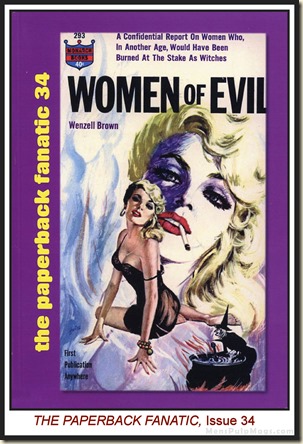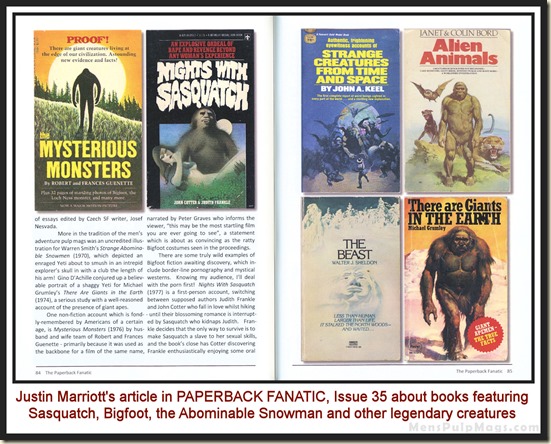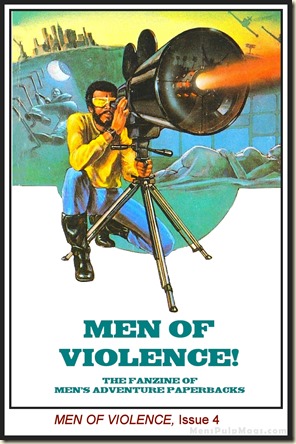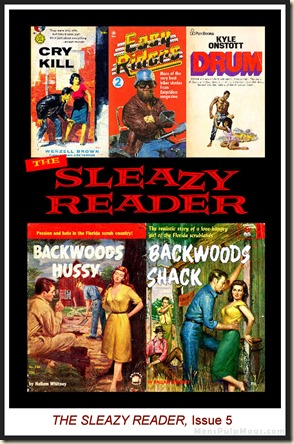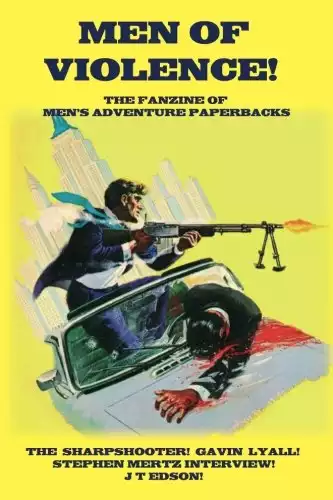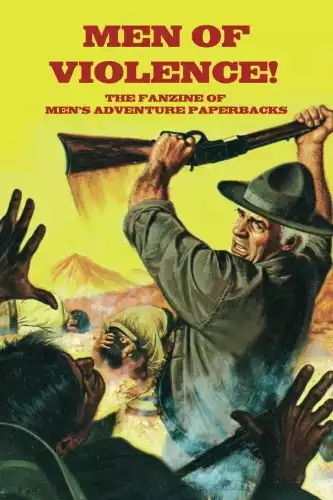
EDITOR’S NOTE: I first learned about vintage paperback fanzine publisher Justin Marriott from my friend writer, editor and action/adventure media maven Paul Bishop (whose latest book is 52 WEEKS • 52 WESTERN NOVELS, a cool, lushly-illustrated guide to classic and new Western novels).
Paul posted an interview he did with Justin on his wide-ranging blog. He also posted news about the availability of Justin’s newest fanzines in two of my favorite Facebook groups, the Men’s Adventure Paperbacks of the 70s & 80s group and the Men’s Adventure Magazines & Books group.
Justin, who lives in the UK, began publishing his flagship fanzine THE PAPERBACK FANATIC in 2007. In the years since then he has added THE SLEAZY READER, PULP HORROR and my new favorite, MEN OF VIOLENCE, which focuses on men’s action/adventure novels, from the best-known, like Don Pendleton’s EXECUTIONER series, to obscure titles that I, for one, probably would not have heard of if not for Justin’s MOV fanzine.
Ironically, earlier this year, Justin had learned about my MensPulpMags.com blog and the anthologies of men’s adventure books I publish with Wyatt Doyle thanks to interviews Paul had done with us and posted on his blog.
Justin and I eventually linked up via email and discovered we had a mutual admiration for each other’s publications and research into the related realms of vintage paperbacks and men’s adventure magazines.
Justin’s fanzines are chock full of fascinating facts about authors and publishers. They include insightful overviews of books that can lead you to new reading adventures – or save you time by making you aware that some are not your cuppa. Each issue is also nicely illustrated with cover scans and other photos, originally published in black-and-white in older issues, now in glorious full color in newer ones.
 In Issue 36 of THE PAPERBACK FANATIC, Justin reprinted an interview Paul had done with Wyatt and I about our book BARBARIANS ON BIKES, a visual archive of men’s adventure magazine covers and interior illustrations that feature bikers and motorcycle gangs.
In Issue 36 of THE PAPERBACK FANATIC, Justin reprinted an interview Paul had done with Wyatt and I about our book BARBARIANS ON BIKES, a visual archive of men’s adventure magazine covers and interior illustrations that feature bikers and motorcycle gangs.
This past summer, when Justin asked if he could reprint a post I’d done about the late, great men’s adventure mag writer Walter Kaylin in MEN OF VIOLENCE, Issue 8, I was honored and happy to agree. (That issue also includes an excellent article by Paul Bishop about the gritty FARGO book series written by Ben Haas, under the pseudonym John Benteen.)
In the next issue of MEN OF VIOLENCE, Issue 9, Justin posted a very nice review of our collection of “killer creature” stories from MAMs, I WATCHED THEM EAT ME ALIVE. He also reprinted a blog post I’d done about the first issue of the men’s adventure mag BATTLE CRY.
Reading Justin’s fanzines has made me more aware than ever of the many connections between vintage men’s adventure magazines (MAMs) and men’s adventure paperbacks (MAPs). Those connections include more than just types of stories.
Men’s adventure magazines published hundreds of “Book Bonus” versions or excerpts of popular action, adventure, mystery and thriller paperbacks. And, many writers who wrote stories for or edited men’s adventure magazines also wrote action/adventure paperback books.
I ran across one example in MEN OF VIOLENCE, Issue 4. In that issue, Justin wrote about the Nick Carter novels penned by Martin Cruz Smith in the early 1970s, before GORKY PARK boosted him into the ranks of top-selling novelists in 1981.
In the late 1960s and early 1970s, Cruz Smith wrote stories for and worked as an Editor for several of Martin Goodman’s Diamond/Atlas MAMs. He used the name Bill Smith as an editor on mastheads of FOR MEN ONLY and ACTION FOR MEN. He wrote stories for those and other Mag Mgt. mags under the names Martin Cruz and Tom Irish.
Another article in MOV 4, also by Justin, is about one of the great pulp fictioneers, Lou Cameron. Cameron was a regular contributor of stories to men’s adventure magazines. He also wrote scores of action/adventure paperbacks under his own name and under various pseudonyms (Tabor Evans for the LONGARM adult Western series and Ramsay Thorne for the “Captain Gringo” RENEGADE adult Westerns).
Most of the top men’s adventure magazine artists, such Mort Kunstler, James Bama, Gil Cohen, Bruce Minney, Samson Pollen and many others, also did cover paintings for paperbacks in the ‘50s, ‘60s and ‘70s.
MAMs and paperbacks are also connected by publishers and editors. Some day, Justin, Paul, Wyatt and I should work together on an article about those various connections.
I recently emailed Justin some questions about his fanzines and his future plans for them.
I was intrigued by the fact that he’d started selling print copies of them on Amazon, which is very good news for his readers in the US and elsewhere.
Previously, he published limited runs of each issue and shipped them by mail from the UK. Most issues sold out quickly. You had to be on your toes, and a bit lucky, to even get copies. Now, using CreateSpace, Justin has made his fanzines accessible as Print on Demand publications worldwide.
Below is my Q&A with Justin, illuminated with scans from his fanzines. For an even more in-depth interview with him, click this link to Paul Bishop’s blog.
BOB DEIS: What made you decide to start publishing your fanzines via POD on Amazon and what has been the reaction from readers?
JUSTIN MARRIOTT: Although I had been resisting POD for a number of years, because it just seemed at odds with the fanzine culture I was most familiar with (horror film zines from the 90s in which you sent off coins sellotaped to a card and a SAE and then waited to see what, if anything at all, come back), in my heart of hearts, I knew it was a case of when rather than if. The price of international postage was a key driver – it was costing nearly five times more to post MEN OF VIOLENCE from the UK to the USA than it was to print it – which was making it more and more difficult to offer the zine at an accessible price. Lack of time on my part to be promoting the zines and then fulfilling them was also becoming a greater obstacle.
But the kicker for me was the low numbers of copies I was selling relative to the quality of the material I was publishing (I’m talking about pieces and articles from contributors, rather than boasting about my own workman-like writing) and I felt I owed it to the contributors who were evidently putting a lot of time and effort into their pieces, to present their works to a wider audience than I was currently achieving. To an extent this limited audience was a self-fulfilling prophecy due to me not having sufficient time to effectively promote the zines. I knew I needed to evolve.
My road to Damascus moment was courtesy of Paul Bishop, who is both an author and a leading voice in on-line forums dedicated to vintage paperbacks. Paul encouraged me in a positive way to explore POD. Prior to that, various on-line posters had lambasted me for not using POD and making the zines available to suit them when they fancied dipping in and out, typically spouting tosh about business models and commercial benefits. My day job is all about business models and commercial benefits, so this “advice” wasn’t really needed or relevant. I don’t self-publish zines in my spare time for the financial benefits (I don’t think anyone does, or soon realizes there are none). It’s just something that I’ve always done. My parents used to have a folder of all of the comics and fanzines I produced when still living at home – and I think it’s something I will always do. Unlike others dispensing their pearls of wisdom via social media, Paul had the right combination of being able to talk from experience and being able to relate to me why POD could fit in with my own philosophy when it came to self-publishing.
Once I tried it, I soon went from dipping my toe in the POD water with a reprint of an out-of-print issue of MEN OF VIOLENCE, into diving in head-first, and from now on all of my zines will be exclusively through POD. I do have some concerns that the quality is not the same as traditional print, but the simplicity of Amazon fulfilling all orders compensates for this, as I now have more time to focus on the quality of the writing and design.
US readers have responded positively, whether that is existing readers appreciating the reduction in cost and increase in convenience, or new readers who would have never ordered a zine directly from me but trust the Amazon brand. UK readers are less enthusiastic at this stage, but I’m guessing the barriers POD has removed were mainly for overseas readers. Certainly keeping titles in print is seen as a positive thing by new readers who can pick them up whenever they hop on.
One thing that is interesting to me, is that I receive much less correspondence from Amazon customers despite listing my e-mail in the zines and asking for correspondence. I theorize that ordering through Amazon rather than from me as an individual brings a different dimension to the editor/reader relationship. The pre-POD readership of the FANATIC have been on board for many, many years now, so I felt like we were a collective of some sort and I kind of knew who my readers were. Now I have no idea for the most part! I’ve also noticed that people are more likely to post a picture of the mag on social media and comment there, putting it on public display, rather than writing to me directly. I think I like it as it spreads the word, but it strikes me that ten years ago fanzine editors would have been saying no one sends them handwritten letters anymore and it’s all email. It just shows how trends in communications and interactions are evolving all the time.
BOB: Are you planning to eventually reprint all of your past issues in POD format? There are so many fascinating articles in them that I know would be interest to fans of the books Wyatt and I publish. By the way, I’m always amazed at how many overlapping interests you and I have. For example, you wrote an article for Issue 35 of THE PAPERBACK FANATIC that focuses on vintage paperbacks about Sasquatch, Bigfoot and other legendary manlike monsters. That’s one of my favorite topics, as you know from our book collecting classic monster stories and artwork from men’s adventure magazines, the CRYPTOZOOLOGY ANTHOLOGY. And, in PULP HORROR, Issue 5 you’ve got an article about the Italian fumetti adult comic books, which have wild bondage and torture covers that are similar to the men’s adventure “sweat magazine” subgenre.
JUSTIN: I think I will redo all of the issues of MEN OF VIOLENCE eventually, and am currently starting to dig books out my shelves at the moment to start rereading and scanning for a reprint of issue two. But in total I’ve published nearly 60 fanzines dedicated to vintage paperbacks over the last decade, so it’s unlikely I’ll bring them all back, mainly because it would take so much time to move them into the POD formats I wouldn’t get a chance to work on new stuff.
Also, I am not a natural “completer/finisher” which means I have to be very disciplined about finishing the last 10% of any issue (this is why the mags contain more typos and SNAFUS than they should – I just lose the mojo at the final stages of production) and as a result, normally hate an issue by the time it is published and never want to see it again. I’m all about the buzz of prepping the next issue. So the thought of having to face them again, is not an appealing one to me.
And as my writing has changed hopefully for the better over the years, I couldn’t just republish the older material as it was and would feel compelled to rework it. That would gobble up time I would rather spend looking forward at new material and projects.
BOB: Will all of your future issues be in POD only, or will you also continue to sell print copies directly via your website?
JUSTIN: My four current zines – THE PAPERBACK FANATIC, THE SLEAZY READER, PULP HORROR and MEN OF VIOLENCE – are all POD only from here on in!
BOB: In the past year, you seem to have shown an increasing interest in men’s adventure magazines. What views and observations do you have about them and their connections to the vintage paperbacks you feature in your fanzines?
A few years ago I started to run a regular feature in THE PAPERBACK FANATIC entitled “Artists Assemble” which focused on artists that although known for their paperback covers, also worked in other medium such as comics and magazines. It soon became apparent there was a material crossover into the men’s adventure magazine field, with some of my favorite paperback artists such as Earl Norem, Mel Crair, John Duillo and Bob Larkin, also doing their stuff for the MAMs. From there I also started to look at authors that worked in more than just paperbacks, and again was surprised at the crossover into the MAMs. Dean Ballenger, author of one of my favorite men’s adventure series, is a great example as he was prolific in the MAMs. The thought of all that undocumented material, as most MAM coverage is focused on the cover art, is an exciting one. I feel that way about the interior art, with snippets I’ve seen in magazine ADAM, admittedly more a girlie mag rather than MAM, also deserving of more coverage and analysis.
I have a blurred picture in my mind of the 1960/70s paperbacks that I adored from lower-rung publishers being the successors to the MAMs with their lurid packaging and near-to-the-knuckle themes. The picture is blurred as I know little about the MAMs, but this is where your blog and books are like pixelated slices of heaven for me. The examples you’ve run of dummy paperback covers on MAMs and the extracts of books they ran, often retitled to fit in with the MAMs, strike me as a potentially fascinating chapter of paperback culture that deserves greater coverage. I’ve got no intention of treading on your toes Bob, nor can I match your collection and knowledge, so I hope I can lure you into contributing more to my zines on the subject.
BOB: Absolutely! I’m in! By the way, who are some of your favorite writers and artists in the realm of action/adventure paperbacks and men’s adventure mags?
JUSTIN: I’m always reticent about offering my recommendations as I tend to be slightly skewed in my view of their worth. I read so many paperbacks as research for the zines that I can get a bit jaded and therefore the more outrageous and whacked-out stuff tends to grab my attention, rather than well-crafted and slick material. And also, I take notice of technical accuracy at all. I never understand why fans of men’s adventure or western fiction can get so hot under the collar about trigger actions on guns or bullet velocities. If you want challenge lack of reality in your fiction, why not also pick up on the fact the hero manages to survive endless shoot-outs, escapes any situation not matter how tricky, is a hugely-endowed stud with an endless array of beautiful women throwing themselves at him, never goes to the toilet or eats, and so on. I never quite get why it’s the weapons that is the sole focus in terms of the need for accuracy.
I think I can recommend without hesitation the works of two British thriller writers – Desmond Bagley and Jack Higgins. Anything by Bagley, but suggest RUNNING BLIND or HIGH CITADEL as high-points, and any early Higgins before he started repeating himself.
In the men’s adventure category, it’s definitely the more outrageous stuff I gravitate towards: the GANNON trilogy by Dean Ballenger [wonderfully reviewed by paperback maven Joe Kenny on his great Glorious Trash blog]. In the GANNON series, Ballenger channels Mickey Spillane for a trilogy containing bizarre slang and brutal violence perpetrated by a psychotic Robin Hood type. I also like the gritty and nihilistic Keller books by Nelson de Mille in which the suburbs of New York City are the major characters; and the TNT series by Doug Masters at Pinnacle, which were translations of an O.T.T. French pulp series which is comic-book in tone.
For westerns, I would call out the FARGO and RENEGADE series, which I think transcend their genre roots, although RENEGADE in particular may be too cynical and explicit for some tastes. And as a UK citizen, I need to call out one of the western series from these islands, and choose HERNE THE HUNTER, which was never published in print format in the US to the best of my knowledge. One of the later entries riffs on THE TEXAS CHAINSAW MASSACRE! [EDITOR’S NOTE: The Herne series is now available in Kindle format.]
BOB: I’m also a fan of the FARGO series, which Paul Bishop turned me on to. By the way, Samson Pollen, one of the great men’s adventure magazine artists, did cover paintings for the RENEGADE paperbacks. Are there certain websites and reference books you use regularly to do your research on vintage paperbacks?
JUSTIN: Oh yes! And they are very useful in making me look far more knowledgeable than I really am, so not sure if I should reveal them… but seeing as it’s you Bob….
Online resources I typically refer to include Bookscans.com, Pulpcovers.com, Lynn Munroe’s website and book catalogs and the Vault of Evil: Brit Horror Pulps forum.
Fanzine-wise there is Gary Lovisi’s PAPERBACK PARADE which is fast-approaching is 100th issue, the out-of-print BOOKS ARE EVERYTHING [published by R.C. & Elwanda Holland], COLLECTING PAPERBACKS [published by Lance Casebeer] and the PAPERBACK QUARTERLY.
Books include Graham Holroyd’s PAPERBACK PRICES guide and HAWK’S GUIDE TO PSEUDONYMS. For inspiration I turn to XEROX FEROX, which includes a block of interviews with editors of 1990s horror film fanzines.
I have been caught out in the past by believing everything that is listed on Google, so I now tend to ensure any information can be verified by two separate sources, although even recently I stated something about Harry Whittington’s career and when asked about it, have struggled to locate my original source. So I’m still a work-in-progress.
BOB: I’m amazed at and envious of your output. Do you still have a regular job full time? How do you find time to do all the research, scanning and layouts for your fanzines, and how long does it take you to put together an issue?
JUSTIN: Thanks for the kind words. To be honest, I can’t think of any words to describe it other than an obsession. Hopefully on the healthy side of obsession, but still a burning, irresistible, all-consuming compulsive obsession. Hopefully I’ve painted a picture for you?
I do have a full-time job, working as a project manager in the Digital division for one of the UK’s largest companies. I’ve worked at the same company since I left school! And I also have a young family, which is my absolute priority. So zine-time is limited and I try to be disciplined in my approach to pulling together an issue.
Basically I spend a couple of hours each night working on the zines – all elements from research, writing, scanning, editing and correspondence. I have music on in the background, but otherwise I totally focus on the job in hand. In my day job I am used to pressure and tight deadlines, so I just carry that focus and work ethic over into my fanzines. Whereas I guess normal people spend the evening watching Netflix or funny cat videos on You Tube, I spend it putting together small-press zines. It’s something that is part of who I am. The main downside is that when I do occasionally have a night where I do watch funny cat videos on You Tube, I feel extremely guilty and frustrated that I’ve wasted a few hours that I could have spent preparing a new issue.
I am always quite surprised at how quickly I can pull an issue of MEN OF VIOLENCE together. The writing style is looser than my other zines, and is often rawer and more irreverent, which I think reflects the books I cover. Whenever I get writer’s block, I just move onto a different article and so on. So typically, I have five articles on the go simultaneously and flit between them as the mood takes. This is why I don’t have a publishing schedule. I just put out whatever title just happens to come together at a particular point. I’ve also developed a bit of a shorthand for the layouts which takes me less and less time these days. I still think it’s the area in which I can make the most progress, but don’t ever want my zines to ever resemble an over-designed coffee-table book.
I have also had to be sensible in reducing some burdens by inviting more contributors on-board so there is a ‘team’ that I know I can rely on and accepting help from Jim O’Brien who as Assistant Editor for most of my zines does a lot of unsung grunt-work in proof-reading the zine and copy-editing my articles. There are others who do their bit with promotion and supplying of imagery, and I am often humbled by how helpful people are and willing to share their knowledge. The zines wouldn’t be as regular if not for them.
BOB: In the interview you did a while back with writer Paul Bishop, you mentioned you might start a new fanzine about vintage Western paperbacks. Is that on your to do list for 2018?
JUSTIN: I have been promising myself for a few years that I would publish a zine dedicated to Westerns, but my normal sounding-boards have all advised me it would be a disaster. This has only increased my determination to do it, but HOT LEAD (as it is provisionally titled) has never got to the top of my to-do list. However, with Paul on board as a contributor who is both knowledgeable and an excellent writer, I now feel as if I have a co-conspirator and hope to be able to publish a first issue in 2018. The western genre fascinates me, as it’s never been critically acclaimed but has out-lasted pretty much any other category of genre-fiction. When I visit used book stores (not as often as I would like due to lack of time and used book stores) these books are becoming thinner on the ground, so someone out there is buying them. But not many are prepared to ‘fess up. So the whole concept of a fanzine dedicated to this maligned yet enduring genre of books is hugely appealing to me.
BOB: Wow! A Western fanzine with you and Paul at the helm will definitely be cool! I look forward to it and have many examples of Western stories and artwork in men’s adventure magazines you could tap if you want. Thanks again for talking with me, Justin – and for your great zines.
* * * * * * * * * *
Comments? Corrections? Post them on the Weasels Ripped My Book Facebook Page, email them to me,
or join the Men’s Adventure Magazines & Books Facebook Group and post them there.
RELATED READING…





